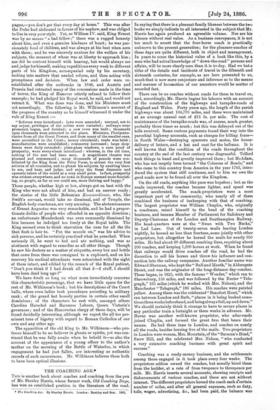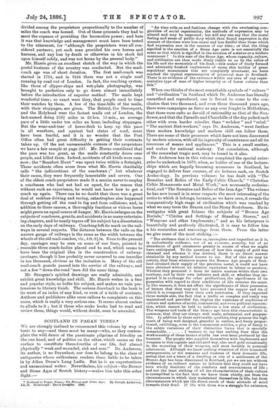THE COACHING AGE.*
Tins is another book about coaches and coaching from the pen of Mr. Stanley Harris, whose former work, Oki Coaching Days, has won an established position in the literature of the road.
• The Coaching Age. By Stanley Harrill. London : Bentley and Son. 1885.
In saying that there is a pleasant family likeness between the two books we simply indicate to all interested in the subject that Mr. Harris has again produced an agreeable volume. Nor are his labours without real value. As a business conveyance, it is not too much to assert that the four-horse coach is practically unknown to the present generation; for the pleasure-coaches of these days are quite different, both in object and management. In years to come the historical value of a book like this, by a man who had actual knowledge of " down-the-road" persons and affairs, will be more clearly seen than it is to-day. Had we but a tithe of the details and incidents of travel in the fifteenth and sixteenth centuries, for example, as are here presented to us, much that is now mere conjecture and inference as to the means and manner of locomotion of our ancestors would be matter of recorded fact.
There can be no coaches without roads for them to travel on, and, accordingly, Mr. Harris begins his labours with an account of the construction of the highways and turnpike-roads of England and Wales. Forty years ago, the length of the parish highways was about 104,770 miles, and these were maintained at an average annual cost of £11 3s. per mile. The cost of maintenance of the turnpike-roads was, of course, much greater, probably three times as much ; but this was defrayed out of the tolls received. Some curious payments found their way into the parochial highway accounts, such as charges for killing foxes— in South Wales—destroying sparrows and moles, the house- delivery of letters, and a hat and coat for the bellman. It is well known that the condition of the roads throughout the country at the end of the last century was disgraceful. Telford took things in hand and greatly improved them ; but McAdam, who has not inaptly been termed " the Colossus of Roads," and who came to this country from America in the year 1783, intro- duced the system that still continues, and to him we owe the good roads now to be found all over the Kingdom.
On the old roads, anything like pace was hopeless ; but as the roads improved, the coaches became lighter, and speed was greatly accelerated. The coach-proprietors were a most important part of the community, who• nearly all of them combined the business of innkeeping with that of coaching. The largest proprietor was William Chaplin, who, originally a coachman, raised himself to the head of the coaching business, and became Member of Parliament for Salisbury and Deputy-Chairman of the London and Southampton Railway. His head-quarters were at the " Swan with Two Necks," in Lad Lane. Oat• of twenty-seven mails leaving London nightly, he horsed no less than fourteen, some jointly with other proprietors, but altogether he horsed the mails for nearly 350 miles. He had about 68 different coaching lines, requiring about 200 coaches, and keeping 1,200 horses at work. When he found that railways would drive coaches off the road, he had the discretion to sell his horses and throw his influence and con- nection into the railway companies. Another familiar name was Edward Sherman, who kept the " Ball and Month," in Aldersgate Street, and was the originator of the long-distance day-coaches. These began, in 1825, with the famous " Wonder," which ran to Shrewsbury, 158 miles, and was followed by the Exeter "Tele- graph," 165 miles (which he worked with Mrs. Nelson), and the Manchester " Telegraph," 186 miles. His coaches were painted yellow. Among them was the celebrated "Beaufort Hunt," which ran between London and Bath, " places in it being booked some- times three weeks beforehand, and being alway s full, up and down." We should certainly think it strange to have to secure places in any particular train a fortnight or three weeks in advance. Mr. Home was another well-known proprietor, who afterwards joined Chaplin, and formed the great firm that bears their names. He had three inns in London, and coaches on nearly all the roads, besides horsing five of the mails. Two proprietors in London were women, Mrs. Mountain, of the " Saracen's Head," Snow Hill, and the celebrated Mrs. Nelson, "who conducted a very extensive coaching business with great spirit and success."
Coaching was a ready-money business, and the settlements among those engaged in it took place every four weeks. The proprietors seldom owned the coaches, but usually hired them from the builder, at a rate of from twopence to threepence per mile. Mr. Harris inserts several accounts, showing receipts and disbursements of various coaches, and these are not without interest. The different proprietors horsed the coach each ecertain number of miles, and after all general expenses, such as duty, tolls, wages, advertising, &c., had been paid, the balance was divided among the proprietors proportionally to the number of miles the coach was horsed. Out of these proceeds they had to meet the expense of providing the locomotive power ; and here it was that knowledge and management must have been tested to the uttermost, for "although the proprietors were all con- sidered partners, yet each man provided his own horses and harness, and any loss by death or otherwise in his stock fell upon himself solely, and was not borne by the general body."
Mr. Harris gives an excellent sketch of the way in which the postal business of the country was conducted. But the mail- coach age was of short duration. The first mail-coach was started in 1784, and in 1844 there was not a single mail running by road out of London. In fact, the coaching system, like those of clipper-ships and wet-plate photography, was brought to perfection only to go down almost immediately before the introduction of superior method. The mails kept wonderful time ; so exact were they, that people used to time their watches by them. A few of the time-bills of the mails, with their stoppages, are given. The Bristol, the Devonport, and the Holyhead were the fastest mails out of London, the last-named doing 259-1- miles in 26 hrs. 55 min., an average pace of a little under ten miles an hour, including stoppages. But the wear-and-tear of horse-flesh to keep up this pace in all weathers, and against bad states of road, must have been fearful, and it is no wonder that the Post Office often had great difficulty in getting their contracts taken up. Of the not unreasonable excuses of the proprietors we have a fair sample at page 247. Mr. Horne considered that the pace was too great, as the mails constantly drove over people, and killed them. Indeed, accidents of all kinds were com- mon; the "Beaufort Hunt" was upset twice within a fortnight. These accidents often arose from what Mr. Harris charitably calls " the indiscretions of the coachman ;" but whatever their cause, they were frequently lamentable and severe. One of the oldest coach-proprietors made it a maxim never to employ a coachman who had not had an upset, for the reason that without such an experience, he would not know how to get a coach up again. There can be no doubt that there was a great deal of reckless driving and racing, catastrophes also happened through getting off the road in fog and from collisions, and, in addition to these causes, a thoroughly fractious or vicious horse might prove an equal source of danger. Mr. Harris enlarges on the subjects of coachmen, guards, and accidents in as many entertain- ing chapters, and he neatly tapers off his subject by a dissertation on the early days of railways. Coaching left its mark on the rail- ways in several respects. The distance between the rails on the narrow gauge of railways is the same as the width between the wheels of the old mail-coaches, viz., 4 ft. 81 in. Even to the present day, carriages may be seen on some of our lines, painted to resemble three coach-bodies placed end to end, which seems to have been the original idea in the construction of railway- carriages, though it has probably never occurred to one traveller in ten thousand, obvious as the imitation is. Many of the old mail-coach guards passed into the service of the railways, and not a few " down-the-road "men did the same thing.
Mr. Stnrgess's spirited drawings are really admirable, and exhibit great knowledge and skill. Mr. Harris writes in a free and popular style, as befits his subject, and makes no vain pre- tensions to literary finish. The serious drawback to the book is its want of an index of any kind, or even of a table of contents. Authors and publishers alike seem callous to complaints on this score, which is really a very serious one. It seems almost useless to allude to it ; but if those who make books had to read and review them, things would, without doubt, soon be amended.



































 Previous page
Previous page